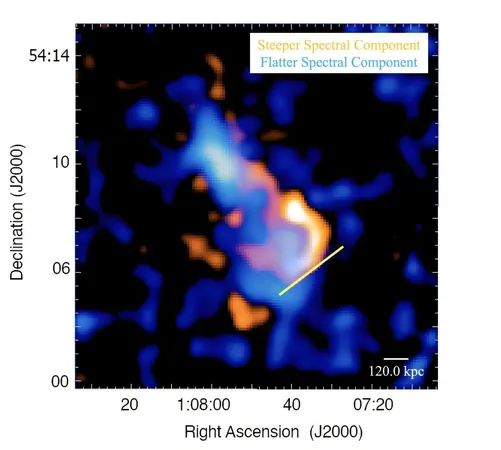
Astronomers Unlock the Secrets of a Nearby Galaxy Cluster Merger: What They Found Will Astound You!
2024-12-30
Author: Wei
Introduction
In an exciting new development in the field of astrophysics, an international team of astronomers has harnessed the power of the Very Large Array (VLA) to investigate a fascinating nearby galaxy merger known as CIZA J0107.7+5408. Their groundbreaking findings were made public on December 20th on the preprint server arXiv, offering fresh insights into the dynamic processes that occur during galaxy cluster mergers.
Understanding Galaxy Clusters
Galaxy clusters, which can house thousands of individual galaxies held together by gravity, are typically formed through the merger of smaller clusters. This cosmic ballet not only gives researchers a chance to study matters in extreme conditions unattainable in earthly laboratories but also sheds light on essential astrophysical phenomena. By examining these merging clusters, scientists can delve deeper into the physics of shocks and cold fronts present in the diffuse intra-cluster medium, probe cosmic ray acceleration, and investigate the intriguing self-interaction properties of dark matter.
The Case of CIZA J0107.7+5408
CIZA J0107.7+5408, or CIZA0107 for short, has a redshift of approximately 0.1, marking it as a nearby, post-core passage, dissociative binary cluster merger. It consists of two roughly equal mass subclusters that exhibit substantial disturbance and are characterized by distinct optical density peaks, alongside their associated but offset X-ray emission peaks.
Research Findings
Leading this astronomical inquiry is Emma Schwartzmann from the U.S. Naval Research Laboratory in Washington, D.C. Her team has employed the VLA to gain a deeper understanding of CIZA0107’s intricate characteristics. They stated, "We present new observations at frequencies ranging from 240–470 MHz and 2.0–4.0 GHz. Our work includes imaging the diffuse emission at a high resolution, constraining its integrated spectrum, and mapping the distribution of the spectral index."
Observations and Results
The VLA observations have revealed the chaotic dynamical state of CIZA0107, demonstrating a merger system that is significantly disturbed, with the merger axis oriented in the northeast-southwest direction. Notably, the findings at 340 MHz and 3.0 GHz show diffuse radio emissions that stretch over an astonishing 1.6 million light-years in each of the two subclusters.
In a particularly striking find, astronomers detected emission from two ultra-steep spectrum regions located northwest and southeast of the main diffuse radio emission peak within the southwestern subcluster. The spectral analysis indicated that both subclusters exhibit a similar spectral index of approximately -1.3. However, the ultra-steep regions displayed even steeper spectral slopes measuring approximately -2.2 and -2.9.
Unique Properties and Implications
Intriguingly, the observations revealed a sharp radio edge associated with the southwestern subcluster at 340 MHz. Yet, fascinatingly, this feature was absent in the 3.0 GHz observations, indicating that the diffuse emission not only extends beyond the shock front but hints at the complex dynamics underlying this cosmic merger.
In conclusion, the researchers posited that the unique properties observed in CIZA0107 could suggest the presence of a double halo structure within the system, or that this diffuse emission might arise from two relics superimposed on the central region of the cluster. These findings hold significant implications for our understanding of cosmic structure formation and the mysterious forces that shape our universe.
Conclusion
Stay tuned as these incredible cosmic stories unfold!


 Brasil (PT)
Brasil (PT)
 Canada (EN)
Canada (EN)
 Chile (ES)
Chile (ES)
 Česko (CS)
Česko (CS)
 대한민국 (KO)
대한민국 (KO)
 España (ES)
España (ES)
 France (FR)
France (FR)
 Hong Kong (EN)
Hong Kong (EN)
 Italia (IT)
Italia (IT)
 日本 (JA)
日本 (JA)
 Magyarország (HU)
Magyarország (HU)
 Norge (NO)
Norge (NO)
 Polska (PL)
Polska (PL)
 Schweiz (DE)
Schweiz (DE)
 Singapore (EN)
Singapore (EN)
 Sverige (SV)
Sverige (SV)
 Suomi (FI)
Suomi (FI)
 Türkiye (TR)
Türkiye (TR)
 الإمارات العربية المتحدة (AR)
الإمارات العربية المتحدة (AR)